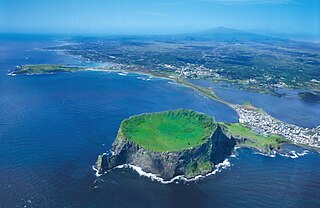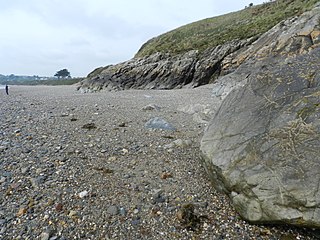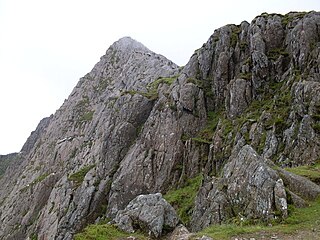
Tuff, also known as volcanic tuff, is a type of rock made of volcanic ash ejected from a vent during a volcanic eruption. Following ejection and deposition, the ash is compacted into a solid rock in a process called consolidation. Tuff is sometimes erroneously called "tufa", particularly when used as construction material, but properly speaking, tufa is a limestone precipitated from groundwater. Rock that contains greater than 50% tuff is considered tuffaceous.

In geology and related fields, a stratum is a layer of sedimentary rock or soil, or igneous rock that was formed at the Earth's surface, with internally consistent characteristics that distinguish it from other layers. The "stratum" is the fundamental unit in a stratigraphic column and forms the basis of the study of stratigraphy. A stratum can be seen in almost every single country in the world.
Tuff Gong is the brand name associated with a number of businesses started by Bob Marley and the Marley family. 'Tuff Gong' comes from Marley's nickname, which was in turn an echo of that given to founder of the Rastafari movement, Leonard "The Gong" Howell.

The West Elk Mountains are a high mountain range in the west-central part of the U.S. state of Colorado. They lie primarily within the Gunnison National Forest, and part of the range is protected as the West Elk Wilderness. The range is primarily located in Gunnison County, with small parts in eastern Delta and Montrose counties.

The Mount Pleasant Caldera is a large eroded Late Devonian volcanic caldera complex, located in the northern Appalachian Mountains of southwestern New Brunswick, Canada. It is one of few noticeable pre-Cenozoic calderas, and its formation is associated to a period of crustal thinning that followed the Acadian orogeny in the northern Appalachian Mountains. It sits relatively near to the coastline.
The Rotliegend, Rotliegend Group or Rotliegendes is a lithostratigraphic unit of latest Carboniferous to Guadalupian age that is found in the subsurface of large areas in western and central Europe. The Rotliegend mainly consists of sandstone layers. It is usually covered by the Zechstein and lies on top of regionally different formations of late Carboniferous age.
Tuff TV was an American digital broadcast television network targeted at men owned by the Tuff TV, Inc. division of Seals Entertainment Corporation. Tuff TV launched on June 30, 2009, and ceased operations August 26, 2018.
Igneous rocks are found in Bukit Timah, Woodlands, and Pulau Ubin island. Granite makes up the bulk of the igneous rock. Gabbro is also found in the area and is found in an area called Little Guilin, named for its resemblance to Guilin in South China. This area is in Bukit Gombak. Sedimentary rocks are found on the western part of Singapore, which is mainly made of sandstone and mudstones. It also includes the southwestern area. Metamorphic rocks are found in the northeastern part of Singapore, and also on Pulau Tekong, off the east coast of Singapore. The rocks are mainly made up of quartzite, and also make up the Sajahat Formation.
The Longmyndian Supergroup is a 6,000-metre-thick (20,000 ft) sequence of Late Precambrian rocks that outcrop between the Pontesford–Linley Fault System and the Church Stretton Fault System in the Welsh Borderland Fault System. The supergroup consists of two major geological groups, the Stretton Group and the overlying Wentnor Group. The rocks are a generally regressive sequence from basinal facies to clastic sedimentation. The rocks are thought to be derived from Uriconian mountains that were formed during the southward subduction of an oceanic plate beneath a continental block. The rocks have since been folded due to fault movements and plunge gently to the south.

Seongsan Ilchulbong, also called ‘Sunrise Peak’, is an archetypal tuff cone formed by hydrovolcanic eruptions upon a shallow seabed about 5 thousand years ago. Situated on the eastern seaboard of Jeju Island and said to resemble a gigantic ancient castle, this tuff cone is 182 meters high, has a preserved bowl-like crater and also displays diverse inner structures resulting from the sea cliff. These features are considered to be of geologic worth, providing information on eruptive and depositional processes of hydromagmatic volcanoes worldwide as well as past volcanic activity of Seongsan Ilchulbong itself.
The Drefach Group is an Ordovician lithostratigraphic group in west Wales. The name is derived from the village of Drefach near Meidrim in Carmarthenshire. The Group comprises the Mydrim Shales Formation, the Mydrim Limestone Formation, the Hendre Shales Formation, Asaphus Ash Formation and at its base, the underlying Felin-wen Formation.
The Pebidian Supergroup is an Ediacaran lithostratigraphic supergroup in Pembrokeshire, west Wales. The term 'Pebidian' was coined by geologist Henry Hicks in 1876 and published in a scientific paper in the Quarterly Journal of the Geological Society in the following year. It was named for Pebidiauc, an ancient local name for the St Davids area.

The Fishguard Volcanic Group is an Ordovician lithostratigraphic group in west Wales. The name is derived from the town of Fishguard in Pembrokeshire. This assemblage of rocks has also been referred to as the Fishguard Volcanic Series or Fishguard Volcanic Complex. These rocks are believed to be the source of the 'bluestones' which form a part of the well-known prehistoric monument of Stonehenge in southern England.

The Llanbedrog Volcanic Group is an Ordovician lithostratigraphic group in northwest Wales. The name is derived from the village of Llanbedrog on the Llyn Peninsula where the strata are exposed.

The Snowdon Volcanic Group is an Ordovician lithostratigraphic group in Snowdonia, north-west Wales. The name is derived from Snowdon, the highest peak in Wales where it outcrops. This assemblage of rocks has also been referred to as the Snowdon Volcanic Series.

The Las Guijas Mountains are a small northwest - southeast trending mountain range in southern Pima County, Arizona. The range is approximately 12 kilometres (7.5 mi) long by 4 km (2.5 mi). Surrounding ranges includes the Cerro Colorado Mountains to the northeast, the Tumacacori Mountains of Santa Cruz County to the east, the San Luis Mountains to the south and the Baboquivari Mountains across the Altar Valley to the west. Arivaca is immediately to the southeast and the old mining townsite of Las Guijas is in the wash just north of the range.
The Caerfai Group is a Cambrian lithostratigraphic group in west Wales. The name is derived from Caerfai Bay on the north coast of St Brides Bay on the Pembrokeshire coast where the strata are well exposed in coastal cliffs. This rock succession has previously been known variously as the Caerfai Series, Caerfai Formation and Caerfai Beds and largely ascribed to the British regional stratigraphic unit Comley Epoch, though these terms are now obsolete.

The Menevian Group is a Cambrian lithostratigraphic group in west Wales. The name is derived from Menevia, the Roman name for the St Davids area north of St Brides Bay on Pembrokeshire’s west coast where the strata are well exposed in coastal cliffs. This rock succession has previously been known variously as the Menevian Series and Menevian Beds and largely ascribed to the British regional stratigraphic unit St David’s Epoch, though these terms are now obsolete.
The Battle Formation is a geologic formation of Late Cretaceous (Maastrichtian) age in the Western Canada Sedimentary Basin. It is present throughout much of the central Alberta plains, where it is an important stratigraphic marker in the nonmarine Upper Cretaceous sequence. It was formally named by G.M. Furnival in 1942 and given formation status by E.J.W. Irish in 1970.
Mininco Formation is a geological formation composed of sediments that deposited during the Pliocene in central Chile. Near Angol the formation reaches thicknesses of up to 300 m. The upper strata of the formation contain tuff layers and coal beds that are rich in leaf fossils. Other fossils that have been found in the formation include fresh-water diatoms and bivalves.









